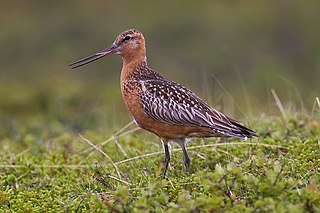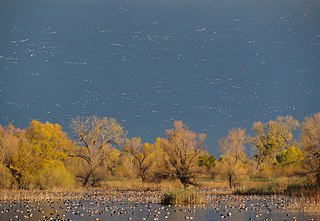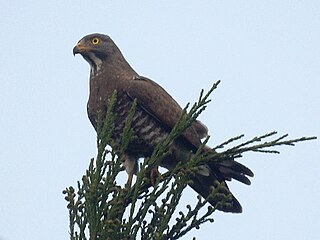Related Research Articles

Grand Isle is a town in Jefferson Parish, Louisiana, United States, located on a barrier island of the same name in the Gulf of Mexico. The island is at the mouth of Barataria Bay where it meets the gulf. As of the 2010 census, the town's resident population was 1,296, down from 1,541 in 2000; during summers, the population, including tourists and seasonal residents, sometimes increases to over 20,000. Grand Isle is statistically part of the New Orleans−Metairie−Kenner Metropolitan Statistical Area, though it is not connected to New Orleans' continuous urbanized area.

The snow goose, consisting of both a white morph and dark morph, is a North American species of goose, collectively with Ross's goose often referred to as "white geese" or "light geese." Its name derives from the typically white plumage. Many taxonomic authorities placed this species and the other "white geese" in the genus Chen. Most authorities now follow the traditional treatment of placing these species in the "gray goose" genus Anser. The scientific name is from the Latin anser, "goose", and caerulescens, "bluish", derived from caeruleus, "dark blue".

Bird migration is the regular seasonal movement, often north and south along a flyway, between breeding and wintering grounds. Many species of bird migrate. Migration carries high costs in predation and mortality, including from hunting by humans, and is driven primarily by availability of food. It occurs mainly in the northern hemisphere, where birds are funneled on to specific routes by natural barriers such as the Mediterranean Sea or the Caribbean Sea.

The mallard is a dabbling duck that breeds throughout the temperate and subtropical Americas, Eurosiberia, and North Africa and has been introduced to New Zealand, Australia, Peru, Brazil, Uruguay, Argentina, Chile, Colombia, the Falkland Islands, and South Africa. This duck belongs to the subfamily Anatinae of the waterfowl family Anatidae. The male birds (drakes) have a glossy green head and are grey on their wings and belly, while the females have mainly brown-speckled plumage. Both sexes have an area of white-bordered black or iridescent blue feathers called a speculum on their wings; males especially tend to have blue speculum feathers. The mallard is 50–65 cm (20–26 in) long, of which the body makes up around two-thirds the length. The wingspan is 81–98 cm (32–39 in) and the bill is 4.4 to 6.1 cm long. It is often slightly heavier than most other dabbling ducks, weighing 0.72–1.58 kg (1.6–3.5 lb). Mallards live in wetlands, eat water plants and small animals, and are social animals preferring to congregate in groups or flocks of varying sizes. This species is the main ancestor of most breeds of domesticated ducks.

The bar-tailed godwit is a large wader in the family Scolopacidae, which feeds on bristle-worms and shellfish on coastal mudflats and estuaries. It has distinctive red breeding plumage, long legs, and a long upturned bill. Bar-tailed godwits breed on Arctic coasts and tundra from Scandinavia to Alaska, and overwinter on coasts in temperate and tropical regions of the Old World, Australia and New Zealand. The migration of the subspecies Limosa lapponica baueri from across the Pacific Ocean from Alaska to New Zealand is the longest known non-stop flight of any bird, and also the longest journey without pausing to feed by any animal. The round-trip migration for this subspecies is over 29,000 km.

The common murre or common guillemot is a large auk. It is also known as the thin-billed murre in North America. It has a circumpolar distribution, occurring in low-Arctic and boreal waters in the North Atlantic and North Pacific. It spends most of its time at sea, only coming to land to breed on rocky cliff shores or islands.

The tree swallow is a migratory bird of the family Hirundinidae. Found in the Americas, the tree swallow was first described in 1807 by French ornithologist Louis Vieillot as Hirundo bicolor. It has since been moved to its current genus, Tachycineta, within which its phylogenetic placement is debated. The tree swallow has glossy blue-green upperparts, with the exception of the blackish wings and tail, and white underparts. The bill is black, the eyes dark brown, and the legs and feet pale brown. The female is generally duller than the male, and the first-year female has mostly brown upperparts, with some blue feathers. Juveniles have brown upperparts, and a grey-brown-washed breast. The tree swallow breeds in the US and Canada. It winters along southern US coasts south, along the Gulf Coast, to Panama and the northwestern coast of South America, and in the West Indies.

The sandhill crane is a species of large crane of North America and extreme northeastern Siberia. The common name of this bird refers to habitat like that at the Platte River, on the edge of Nebraska's Sandhills on the American Plains. This is the most important stopover area for the nominotypical subspecies, the lesser sandhill crane, with up to 450,000 of these birds migrating through annually.

The whooping crane, the tallest North American bird, is an endangered crane species named for its whooping sound. Along with the sandhill crane, it is one of only two crane species found in North America. The whooping crane's lifespan is estimated to be 22 to 24 years in the wild. After being pushed to the brink of extinction by unregulated hunting and loss of habitat to just 21 wild and two captive whooping cranes by 1941, conservation efforts have led to a limited recovery. The total number of cranes in the surviving migratory population, plus three reintroduced flocks and in captivity, now exceeds 800 birds.

The Blackburnian warbler is a small New World warbler. They breed in eastern North America, from southern Canada, westwards to the southern Canadian Prairies, the Great Lakes region and New England, to North Carolina.

The blackpoll warbler is a New World warbler. Breeding males are mostly black and white. They have a prominent black cap, white cheeks and white wing bars. The blackpoll breeds in forests of northern North America, from Alaska throughout most of Canada, to the mountains of New York and New England. They are a common migrant through much of North America. Come fall, they fly South to the Greater Antilles and the Northeastern coasts of South America in a non-stop long-distance migration over open water, averaging 2500 km, one of the longest distance non-stop overwater flights ever recorded for a migratory songbird. Rare vagrants to western Europe, they are one of the more frequent transatlantic passerine wanderers.

The common yellowthroat is a New World warbler. It is an abundant breeder in North America, ranging from southern Canada to central Mexico. The genus name Geothlypis is from Ancient Greek geo, "ground", and thlupis, an unidentified small bird; thlypis is often used in the scientific names of New World warblers. The specific trichas is also from Greek; trikhas is a kind of thrush, the word being derived from trikhos, "hair".

The black-throated blue warbler is a small passerine bird of the New World warbler family. Its breeding ranges are located in the interior of deciduous and mixed coniferous forests in eastern North America. Over the cooler months, it migrates to islands in the Caribbean and Central America. It is very rarely found in western Europe, where it is considered to be a non-indigenous species. The black-throated blue warbler is sexually dimorphic; the adult male has a black face and cheeks, deep blue upperparts and white underparts, while the adult female is olive-brown above and light yellow below.

The Siberian crane, also known as the Siberian white crane or the snow crane, is a bird of the family Gruidae, the cranes. They are distinctive among the cranes, adults are nearly all snowy white, except for their black primary feathers that are visible in flight and with two breeding populations in the Arctic tundra of western and eastern Russia. The eastern populations migrate during winter to China while the western population winters in Iran and formerly, in Bharatpur, India.

The Allegheny Front is the major southeast- or east-facing escarpment in the Allegheny Mountains in southern Pennsylvania, western Maryland, and eastern West Virginia, USA. The Allegheny Front forms the boundary between the Ridge-and-Valley Appalachians to its east and the Appalachian Plateau to its west. The Front is closely associated with the Appalachian Mountains' Eastern Continental Divide, which in this area divides the waters of the Ohio/Mississippi river system, flowing to the Gulf of Mexico, from rivers flowing into Chesapeake Bay and from there into the Atlantic Ocean.

A flyway is a flight path used by large numbers of birds while migrating between their breeding grounds and their overwintering quarters. Flyways generally span continents and often pass over oceans. Although applying to any species of migrating bird, the concept was first conceived and applied to waterfowl and shore birds. The flyways can be thought of as wide arterial highways to which the migratory routes of different species are tributaries. An alternative definition is that a flyway is the entire range of a migratory bird, encompassing both its breeding and non-breeding grounds, and the resting and feeding locations it uses while migrating. There are four major north/south flyways in North America and six covering Eurasia, Africa and Australasia.

The Atlantic Flyway is a major north-south flyway for migratory birds in North America. The route generally starts in Greenland, then follows the Atlantic coast of Canada, then south down the Atlantic Coast south to the tropical areas of South America and the Caribbean. Every year, migratory birds travel up and down this route following food sources, heading to breeding grounds, or traveling to overwintering sites.

The grey-faced buzzard is an Asian bird of prey. It is typically between 41 and 46 cm in length, making it a medium-sized raptor. It breeds in Manchuria, Korea and Japan ; it winters in South-east Asia.

Migrating birds face many perils as they travel between breeding and wintering grounds each year.

Altitudinal migration is a short-distance animal migration from lower altitudes to higher altitudes and back. It is commonly thought to happen in response to climate and food availability changes as well as increasingly due to anthropogenic influence. These migrations can occur both during reproductive and non-reproductive seasons. Altitudinal avian migration is common, and can also be found in other vertebrates, and can be seen in some invertebrates.
References
- 1 2 "Bird Migration and Fallouts". houstonaudubon.org. Houston Audubon Society. 2015. Archived from the original on 26 December 2015. Retrieved 17 November 2015.
- ↑ Bard, Stokke; Moller, Anders; Saether, Bernt-Erik; Rheinwald, Goetz; Gutscher, Hans (April 2005). "Weather in the breeding area and during migration affects the demography of a small long-distance passerine migrant". The Auk . American Ornithologists' Union. 122 (2): 637–647. doi: 10.1093/auk/122.2.637 .
- 1 2 Gill, Jennifer (September 2015). "Encountering extreme weather during migration: individual strategies and their consequences" (PDF). Journal of Animal Ecology . 84 (5): 1141–1143. doi:10.1111/1365-2656.12412. PMID 26376431.
- 1 2 "294 Species and One Shattered Record on 'Almost Perfect' Big Day". birds.cornell.edu. Cornell Lab of Ornithology. 27 April 2013. Retrieved 24 November 2015.
- ↑ "Hurricane Irene redux". ebird.org. eBird. 1 September 2011. Retrieved 24 November 2015.